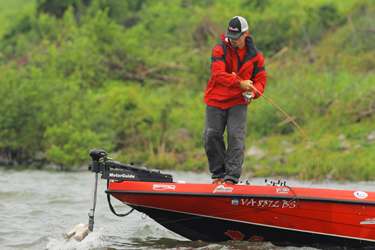
Spring has sprung in the South.
Water temperatures are rising above the 50-degree mark and prespawn bass are moving into the shallows. It's time for John Crews to start cranking.
"Throughout the middle portion of the South on impoundments when the water temperature just cracks over the 50 mark, it seems like a ton of fish move shallow," Crews says. "The bream move up and crappie start moving up getting ready to spawn. Most of the country also has stained water, so the shallow crankbait bite can be absolutely phenomenal that time of year. You can catch some really big fish and some good numbers."
The Bassmaster Elite Series pro targets the middle to back portions of creeks and keys on transition banks where the contour changes from steep to flat.
"A lot of times it correlates with the bottom composition change, where it might go from gravel to red clay or something like that," says Crews. "Those can be key areas where you can catch two or three fish — either on the first pass or throughout the course of the day."
Crews usually casts close to the bank and runs his crankbait less than 4 feet deep. The Virginia angler notes the proximity of his cast to the shoreline depends on the bank slope. "If it's a shallow bank I throw a little farther off; but if it's steep I throw right on the bank."
With his boat positioned parallel to the shoreline, Crews runs his trolling motor at a consistent moderate pace, which allows him to cover a lot of water. Whenever he finds a change in bank composition or depth, Crews makes multiple presentations to these potential hot spots. He'll also run his crankbaits through brushpiles in the backs of pockets when the sun is shining.
"If there's no sun, the fish tend to be on the harder cover such as rocks or bigger logs," he says. "Once you start catching a few fish, quite often there's a pattern that you can start running after that."
Crews' favorite lure for shallow cranking is the Spro Little John in spring craw or root beer chartreuse. His retrieve varies depending on the structure or cover he's cranking.
"If I'm around rocky or harder bottoms, I definitely want contact with the bottom," he says. "If I'm on a little steeper bank where I lose contact with the bottom, I actually stop the retrieve, give the crankbait little short twitches and then continue the retrieve and periodically stop and twitch it a little bit — just like a jerkbait. That Little John is a slow floater, and in that prespawn period it offers the best of both worlds because you can get some of that jerkbait action, but you can also pull it through brushpiles and thicker cover because it's a crankbait."
When he's bumping bottom on a "juicy-looking spot," Crews also employs the stop-and-twitch retrieve to generate more strikes.
"In that prespawn period, the fish really like that stop and start with little twitches and jerks," he says. "It really triggers them."
The 2010 Duel in the Delta winner throws his crankbait on a 7-foot, medium action Pinnacle Perfecta DHC5 rod and a Pinnacle Optimus XT 6.4:1 baitcast reel filled with 12-pound Vicious Ultimate copolymer monofilament line.
"The high-speed reel is very important when shallow cranking because quite often those fish will hit the bait and make a beeline right to you," he says. "They'll come up behind the bait, eat it and keep on trucking; so if you don't have a high-speed reel, you won't be able to keep up with the fish. When it makes that first jump, there will be slack in the line and you can wave to that fish as it jumps off."
A little bit of wind and partly cloudy skies are ideal conditions for Crews' shallow-cranking tactics.
"You can catch them in most any weather as long as it's a warming trend," says Crews. "That is when they really get on that lure."
Originally published March 2011





